If we now reflect the circumcenter over the sides of the triangle, the reflections do not lie on the circumcircle, unless a certain condition is met.
Sixty degrees
In the presence of an interior angle of ![]() or
or ![]() , the reflection of the circumcenter lies on the circumcircle.
, the reflection of the circumcenter lies on the circumcircle.
Let ![]() be the circumradius of the triangle, and let
be the circumradius of the triangle, and let ![]() be its orthocenter. In the diagram below
be its orthocenter. In the diagram below
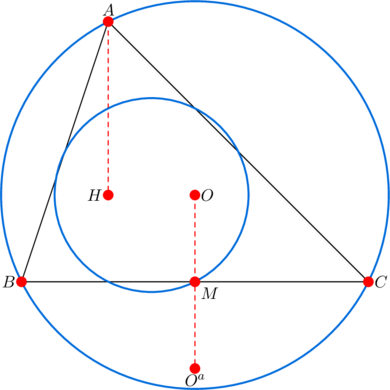
suppose that ![]() actually lies on the circumcircle. Then
actually lies on the circumcircle. Then ![]() must equal
must equal ![]() , right? We showed previously that
, right? We showed previously that ![]() in any triangle with orthocenter
in any triangle with orthocenter ![]() . But then
. But then ![]() always equals
always equals ![]() . And so:
. And so:
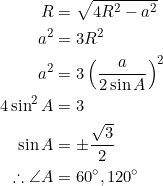
As before, let’s denote by ![]() the reflection of the circumcenter
the reflection of the circumcenter ![]() over side
over side ![]() . We’ll establish the result for the
. We’ll establish the result for the ![]() case.
case.
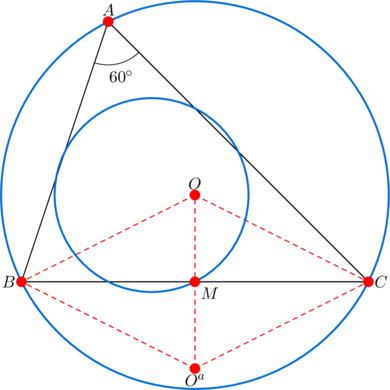
The angle which the minor arc through ![]() and
and ![]() subtends at the center is equal to
subtends at the center is equal to ![]() ; that is, obtuse
; that is, obtuse ![]() , and so reflex
, and so reflex ![]() . Note that
. Note that ![]() is a rhombus, and so obtuse
is a rhombus, and so obtuse ![]() .
.
Since reflex ![]() , we conclude that
, we conclude that ![]() lies on the circumcircle.
lies on the circumcircle.
Simple deduction
As a consequence of the preceding examples, we can characterize equilateral triangles via reflections of the circumcenter.
Easy.
Sample diagrams
Note that this is a right triangle in which ![]() ,
, ![]() , and
, and ![]() . The circumcenter is the point
. The circumcenter is the point ![]() , and its reflection over side
, and its reflection over side ![]() is the point
is the point ![]() .
.
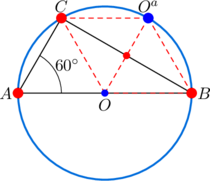
Here, ![]() , and
, and ![]() . An extremely pleasant case.
. An extremely pleasant case.
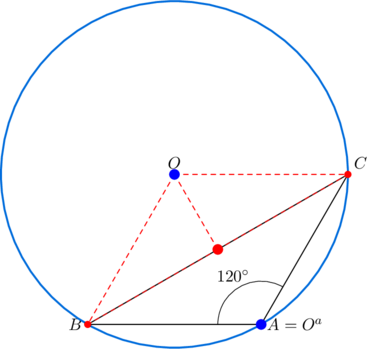
Takeaway
In ![]() , let
, let ![]() be the circumcenter, and let
be the circumcenter, and let ![]() be the reflection of
be the reflection of ![]() over side
over side ![]() . Then the following statements are equivalent:
. Then the following statements are equivalent:

 .
.
And a few more, if you view this post.
Task
- (Late fifties) In a non-right triangle
 , let
, let  be the side-lengths,
be the side-lengths,  the altitudes,
the altitudes,  the feet of the altitudes from the respective vertices,
the feet of the altitudes from the respective vertices,  the circumradius,
the circumradius,  the circumcenter,
the circumcenter,  the nine-point center,
the nine-point center,  the orthocenter,
the orthocenter,  the midpoint of side
the midpoint of side  ,
,  the reflection of
the reflection of  over side
over side  ,
,  the reflection of
the reflection of  over side
over side  , and
, and  the reflection of
the reflection of  over side
over side  . PROVE that the following fifty-seven statements are equivalent:
. PROVE that the following fifty-seven statements are equivalent:
































 is congruent to
is congruent to 
 is congruent to
is congruent to 
 is isosceles with
is isosceles with 
 is isosceles with
is isosceles with 
 is right angled at
is right angled at 
 is the circumcenter of
is the circumcenter of 
 is right-angled at
is right-angled at 
 is right-angled at
is right-angled at 
- quadrilateral
 is a rectangle
is a rectangle - the points
 are concyclic with
are concyclic with  as diameter
as diameter - the reflection
 of
of  over
over  lies internally on
lies internally on 
- the reflection
 of
of  over
over  lies externally on
lies externally on 
- radius
 is parallel to side
is parallel to side 
 is the reflection of
is the reflection of  over side
over side 
- the nine-point center lies on

- the orthic triangle is isosceles with

- the geometric mean theorem holds
- the bisector of
 has length
has length  , where
, where 
- the orthocenter is a reflection of vertex
 over side
over side 
- segment
 is tangent to the circumcircle at point
is tangent to the circumcircle at point 
- median
 has the same length as the segment
has the same length as the segment 
- the bisector
 of
of  is tangent to the nine-point circle at
is tangent to the nine-point circle at 
 is a convex kite with diagonals
is a convex kite with diagonals  and
and 
- altitude
 is tangent to the nine-point circle at
is tangent to the nine-point circle at 
- segment
 is tangent to the nine-point circle at
is tangent to the nine-point circle at  .
.
( short of the target.)
short of the target.)
- (Extra feature) If
 satisfies equation (??), PROVE that its nine-point center
satisfies equation (??), PROVE that its nine-point center  divides
divides  in the ratio
in the ratio  .
.